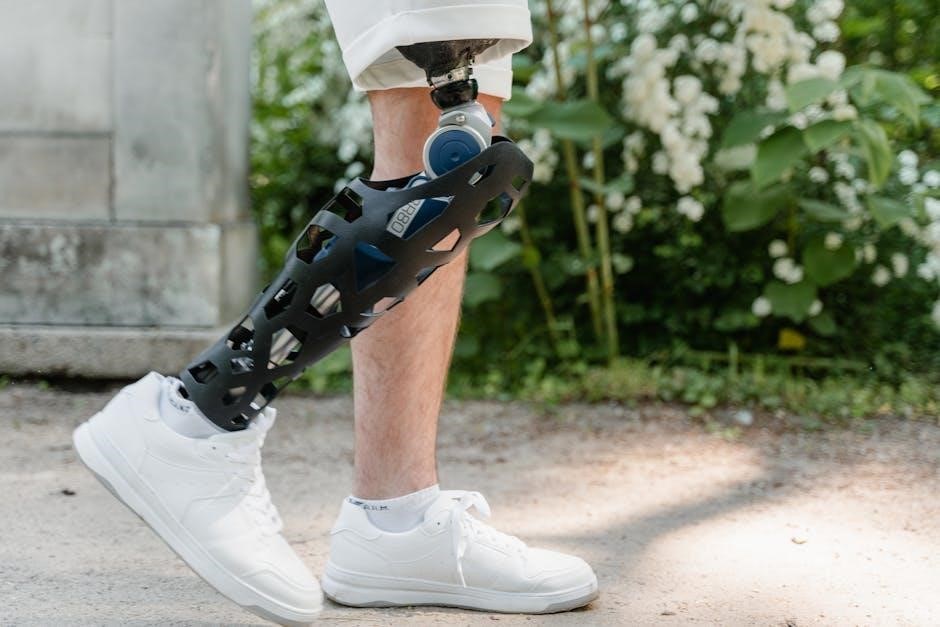Total Knee Replacement (TKR) is a reliable solution for severe knee damage, offering pain relief and improved mobility. The procedure involves replacing the damaged joint with a prosthetic, following a structured protocol to ensure optimal outcomes and minimize complications; Proper preparation, adherence to surgical steps, and post-operative care are critical for success.
1.1 Overview of TKR Surgery
Total Knee Replacement (TKR) is a surgical procedure where damaged knee joint surfaces are replaced with artificial components. It is a widely used solution for end-stage knee osteoarthritis, offering significant pain relief and improved mobility. The surgery involves resurfacing the femur, tibia, and patella with prosthetics, preserving soft tissues. A structured protocol ensures optimal outcomes, with benefits including restored function and enhanced quality of life.
1.2 Importance of Protocol Adherence
Adhering to established protocols in Total Knee Replacement ensures consistency, reduces risks, and enhances recovery. Proper pre-surgical preparation, precise surgical execution, and post-operative care minimize complications. Following guidelines improves outcomes, accelerates healing, and maximizes the longevity of the prosthetic. Compliance with rehabilitation and lifestyle adjustments is crucial for achieving the best results and restoring functional mobility effectively.

Pre-Operative Preparation
Pre-operative preparation is vital for a smooth TKR experience. It includes completing checklists, obtaining medical clearances, and making lifestyle adjustments to optimize health and reduce surgery risks.
2.1 Pre-Surgical Checklists
Pre-surgical checklists ensure patients and caregivers are prepared for TKR. They include medication management, arranging caregivers, preparing the home, and completing medical evaluations. Patients should review and complete all items to avoid delays and ensure safety. These checklists also cover equipment needs and attending pre-operative education sessions to address concerns and questions.
2.2 Medical Evaluations and Clearances
Medical evaluations and clearances are essential to ensure patients are fit for TKR. This includes blood work, imaging, and specialist consultations. Patients must review medications with their doctor and obtain clearance from cardiologists or other specialists if needed. These steps minimize risks and ensure safe surgery, addressing any underlying health conditions before the procedure.
2.3 Lifestyle Modifications Before Surgery
Lifestyle changes before TKR are crucial for optimal outcomes. Patients should focus on weight management, quitting smoking, and reducing alcohol intake. A balanced diet rich in vitamins and minerals is recommended to promote healing. Staying physically active with low-impact exercises improves strength and flexibility, aiding recovery. These modifications enhance overall health and reduce surgical risks, ensuring a smoother procedure and better long-term results.
Surgical Procedure Details
TKR surgery involves replacing damaged knee joint surfaces with a prosthetic. The procedure is precise, preserving ligaments and tendons, and aims to restore natural joint function and mobility.
3.1 Steps Involved in TKR Surgery
TKR surgery involves several key steps: preparing the knee, removing damaged bone and cartilage, implanting the prosthetic components, aligning the patella, and balancing soft tissues. Anesthesia ensures patient comfort, and precise surgical techniques minimize blood loss. The prosthetic is secured, and the joint is tested for proper movement. The procedure typically lasts 1-2 hours, with recovery beginning immediately post-operation.
3.2 Anesthesia and Pain Management Options
TKR surgery typically uses general or regional anesthesia to ensure comfort. Pain management includes epidural, nerve blocks, or local anesthetics. Post-operative strategies may involve medication, ice therapy, and physical therapy to minimize discomfort. Effective pain control is crucial for early mobilization and recovery, reducing risks of complications and improving patient outcomes.

Post-Operative Care
Post-operative care involves monitoring in the recovery unit, pain management, infection prevention, and early mobilization to ensure a smooth recovery process.
4.1 Immediate Recovery in the PACU
In the Post-Anesthesia Care Unit (PACU), patients are closely monitored for vital signs, pain, and bleeding. Pain management begins here, and the care team ensures the patient is stable. Once recovered from anesthesia, patients are transferred to their hospital room, where family or friends may visit. This phase is critical for assessing immediate post-surgical outcomes.
4.2 Hospital Stay and Monitoring
Patients typically stay in the hospital for 1-3 days post-surgery. Continuous monitoring of vital signs, pain levels, and surgical site ensures early detection of complications. Pain management plans are adjusted, and physical therapy begins to restore mobility. Patients are educated on safe movement and medication use, with a focus on preventing infection and promoting healing during their hospital stay.
4.3 Pain Management Strategies
Effective pain management is crucial for recovery. Multimodal analgesics, including oral medications and regional anesthesia, are commonly used. Pain pumps or nerve blocks may be employed to minimize discomfort. Monitoring pain levels ensures adjustments to treatment plans, while patient education on pain recognition and management supports a smoother recovery process and reduces the risk of complications.
Rehabilitation and Recovery
Rehabilitation after TKR focuses on restoring strength, mobility, and function. A tailored approach ensures gradual progression, with patient compliance key to achieving optimal recovery outcomes and independence.
5.1 Physical Therapy Protocol
Physical therapy begins immediately post-surgery, focusing on exercises to restore strength, mobility, and function. A customized protocol ensures gradual progression, supervised by therapists. Early mobilization and home exercises are crucial for recovery. Compliance with the protocol is vital to achieve optimal outcomes and resume normal activities effectively, minimizing complications.
5.2 Home Exercises and Mobility Aids
Home exercises are essential for recovery, focusing on stretching, strengthening, and improving flexibility. Patients are advised to perform daily exercises as prescribed by their physical therapist. Mobility aids like walkers or canes may be recommended to support movement during early recovery. Consistent adherence to the exercise regimen ensures proper healing and restores functional independence effectively.
5.3 Timeline for Full Recovery
Full recovery from TKR typically takes 6-12 months. Immediate recovery involves hospital stay and monitoring, followed by several weeks of home rehabilitation. Patients usually resume daily activities within 6-8 weeks and regain strength by 3-6 months. Full mobility and knee function are achieved by 9-12 months, provided adherence to physical therapy and post-operative protocols is maintained consistently.
Follow-Up and Long-Term Care
Regular follow-ups with your surgeon are essential to monitor healing and address any concerns. Long-term care includes preventative antibiotic use for invasive procedures and maintaining a healthy lifestyle to ensure the longevity of your knee replacement.
6.1 Scheduled Post-Surgery Appointments
Scheduled appointments after TKR are crucial for monitoring recovery and addressing concerns. Typically, follow-ups occur at 2-4 weeks, 3-6 months, and annually thereafter. These visits ensure proper healing, address complications, and assess the prosthetic’s function. Patients should maintain open communication with their healthcare team to adjust rehabilitation plans and address any issues promptly, ensuring long-term success and mobility.
6.2 Preventative Antibiotic Use
Preventative antibiotics are essential after TKR to minimize infection risks. Patients must take antibiotics before dental procedures or invasive surgeries to protect the prosthetic joint. Your surgeon will provide specific guidelines, and adherence is crucial to ensure long-term joint health and prevent complications. Always inform your healthcare providers about your TKR before any procedure;
6.4 Lifestyle Adjustments for Long-Term Success
Lifestyle adjustments are crucial for long-term success after TKR. Maintaining a healthy diet, engaging in regular low-impact exercises, and managing weight are essential. Avoiding high-impact activities and using mobility aids when needed can protect the prosthetic joint. Adhering to these adjustments promotes optimal outcomes and ensures a smooth, durable recovery.

Potential Complications and Risks
Potential complications include infection, blood clots, implant failure, nerve damage, and allergic reactions. Early detection and treatment are crucial.
7.1 Common Post-Surgical Complications
Common complications after TKR include infection, blood clots, implant failure, and nerve damage. Infection is a significant risk, requiring prompt treatment. Blood clots, such as deep vein thrombosis, can occur. Implant failure may necessitate revision surgery. Nerve or tissue damage can cause numbness or weakness. Monitoring and early intervention are critical to managing these issues effectively.
7.2 Signs of Infection or Other Issues
Monitor for redness, swelling, warmth, or increased pain around the knee. Fever, chills, or drainage from the surgical site may indicate infection. Numbness, tingling, or weakness could signal nerve issues. Contact your healthcare provider immediately if these symptoms arise, as early intervention is key to preventing complications and ensuring proper healing.

Patient Education and Resources
Patient education is crucial for successful TKR outcomes. Resources include detailed guides, informed consent documents, and recommended reading materials to help patients understand the procedure and recovery process.
8.1 Informed Consent and Decision-Making
Informed consent ensures patients understand TKR risks, benefits, and alternatives. Surgeons discuss potential complications and outcomes, empowering patients to make informed decisions. This process involves reviewing medical history, discussing anesthesia options, and addressing concerns to ensure patients feel confident in their choice. Clear communication is key to a well-informed decision-making process.
8.2 Recommended Reading and Guides
Patients are encouraged to review the Joint Replacement Handbook and guidebooks provided by their clinical team. These resources cover pre-surgery preparation, recovery tips, and rehabilitation exercises. Additional materials, such as digital guides and informational pamphlets, offer insights into managing expectations and optimizing outcomes. Reading these materials helps patients feel prepared and informed throughout their TKR journey.
Total Knee Replacement is a life-changing procedure offering significant pain relief and improved mobility. Adherence to protocols ensures successful outcomes. Patient commitment to rehabilitation and lifestyle adjustments is key for long-term success and enhanced quality of life.
9;1 Summary of Key Points
Total Knee Replacement (TKR) is a structured procedure offering pain relief and improved mobility for severe knee damage. Key points include pre-surgical preparation, adherence to protocols, and post-operative care. The surgery replaces damaged joints with prosthetics, followed by rehabilitation and lifestyle adjustments. Proper medical evaluations, pain management, and patient commitment are crucial for successful outcomes and long-term success.
9.2 Final Tips for Successful Recovery
Adhere to your physical therapy protocol to restore strength and mobility. Use recommended mobility aids to avoid strain. Follow pain management strategies and attend all scheduled appointments. Take preventative antibiotics as advised to reduce infection risks. Maintain a healthy diet, stay active, and avoid smoking or excessive alcohol. Commitment to these steps ensures a smoother and more successful recovery journey.
